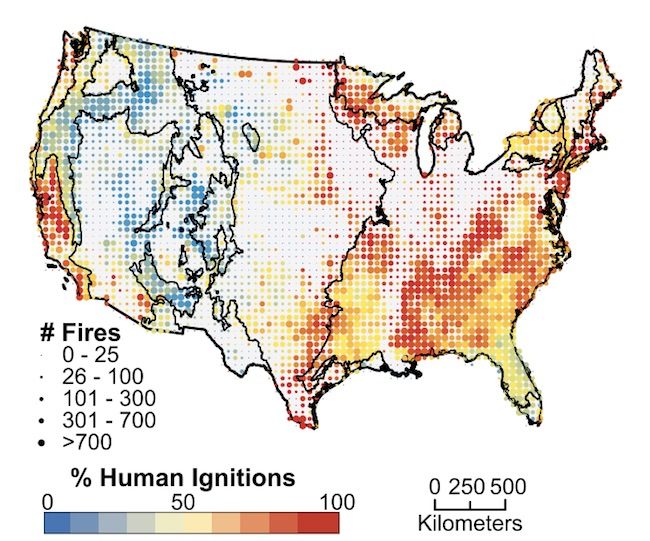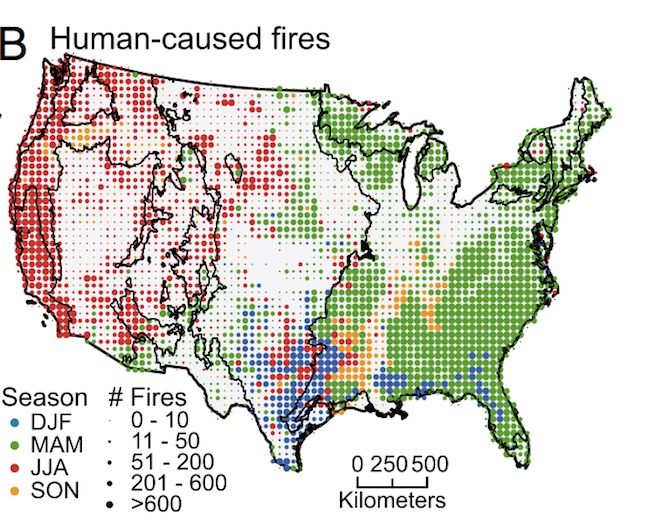Humans Are Responsible for 84 Percent of Wildfires in the U.S.
Only in the mountainous west was lightning a more common cause, a new paper reports.

In the past decades, the number of wildfires in the U.S. has spiraled upwards, as has the cost of fighting them: In recent years, by the end of the fire season, the Forest Service has usually exhausted its budget. According to a new paper, published in the Proceedings of the National Academy of Sciences, one factor contributing to the increasing impact of wildfire is how often humans ignite them.
The team of researchers found that, from 1992 to 2012, people were responsible for starting 84 percent of wildfires and that, in most of the U.S., it’s more common from humans to start wildfires than for lightning to ignite them, as they report in the new paper.
The researchers looked at 1.5 million government records of wildfires that state or federal agencies had to extinguish or manage—wildfires that posed a threat of some sort. Of the 1.5 million fires in their dataset, lightning was responsible for more than 245,000 wildfires; humans were responsible for more than 1,272,000.
The maps above shows where human-ignited fires dominate (the dots in orange and red). The only place in the country where lightning is the main cause of wildfires, the researchers found, is in mountainous parts of the west, where few people live.
Human-ignited fires, the researchers also found, are adding months to the fire season. Whereas lightning-ignited fires happen mostly in the summer months, when fuel is dry and lightning more common, wildfires started by humans are more common in the spring months in the east and in the fall months in the west.
This map shows the season in which lightning is most likely to cause fires. For most places in the country, these fires are most common in the summer:

For comparison, here’s a map showing the season in which humans most likely to cause fires. In the east, human-ignited fires are most common in March, April, and May; the majority of those are started when people burn small piles of debris, like leaves or trash. In parts of the south and the west, human-ignited fires are more common in September, October, and November than in other seasons. (The single day on which people cause the greatest number of wildfires? July 4th.)

“We know globally that climate change is extending the fire season by a couple of weeks,” says Jennifer Balch, an assistant professor of geology at the University of Colorado and the paper’s lead author. “The fact that people are extending it by months is striking.”
The dataset used for this research was compiled by a Forest Service researcher who made it publicly available. Balch and her colleagues stumbled upon it and noticed that, because the data included the cause of the fires, they could look at the spatial and temporal distribution of wildfires started by humans vs. wildfires started by lightning.
Many of the wildfires in the dataset—most of the fire started by debris-burning, for example—are relatively small, but still pose a risk. But people are also playing a role in starting the big wildfires that have run up firefighting expenses and threatened large swaths of land: the most expensive fire in 2016, Balch points out, began after a campfire wasn’t properly extinguished.
The solution, though, may be to better manage the fires human do set—more prescribed burns and control burns, the type of fires that can burn up fuel without endangering either ecosystems or the human settlements. “Given that we’re already starting wildfires, we should be starting more of the right kind,” Balch says.













Follow us on Twitter to get the latest on the world's hidden wonders.
Like us on Facebook to get the latest on the world's hidden wonders.
Follow us on Twitter Like us on Facebook